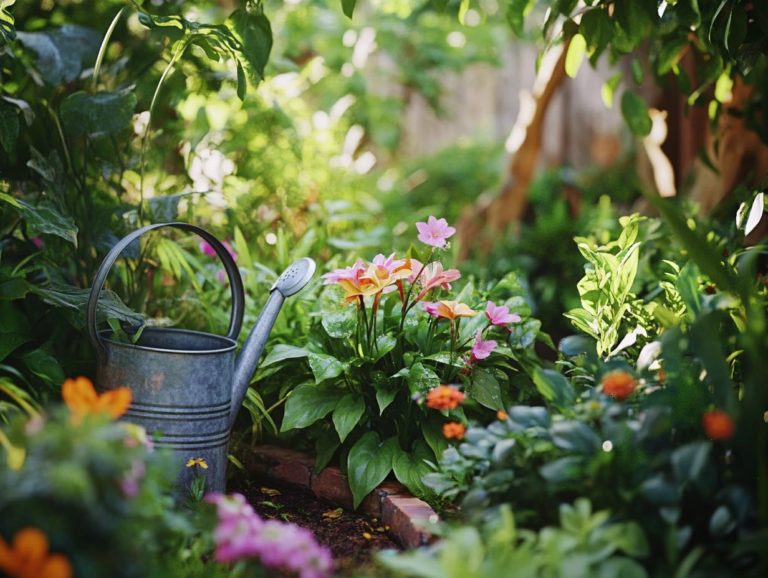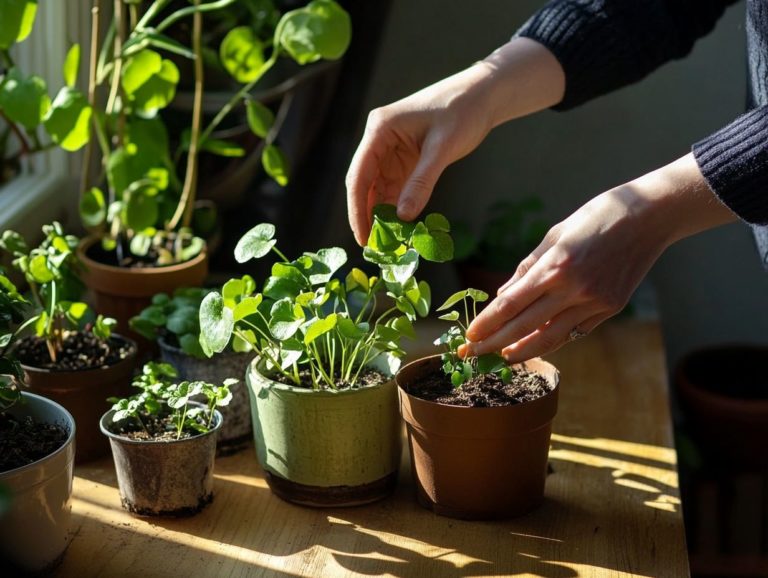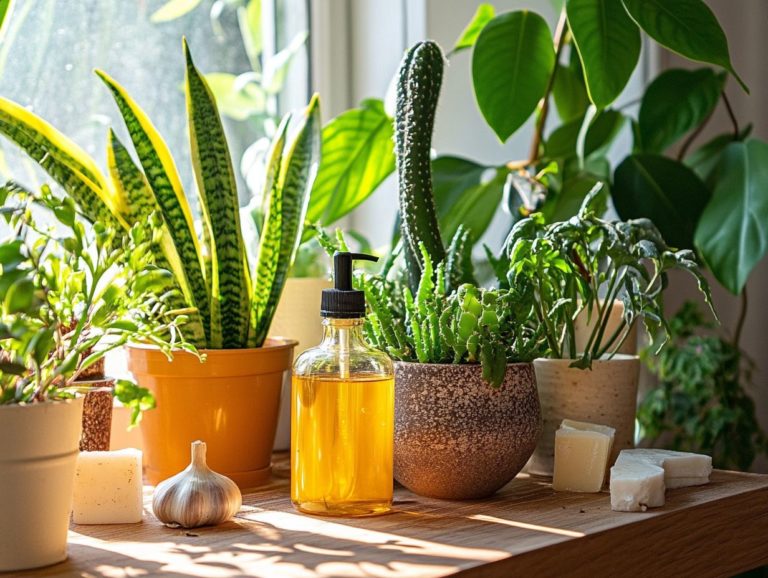How to Use Companion Planting to Manage Pests
Companion planting is a smart gardening technique that utilizes the natural relationships between plants to boost growth, deter pests, and increase your harvests.
This article explores the many benefits of companion planting, especially for pest management. You ll learn about strategies like interplanting, trap cropping, and repellent planting that can protect your garden from unwanted invaders.
We ll guide you in choosing the right plant companions, implementing effective pairings, and avoiding common mistakes.
Prepare to transform your garden into a thriving ecosystem!
Contents
- Key Takeaways:
- Benefits of Companion Planting for Pest Management
- Types of Companion Planting
- Choosing the Right Companion Plants
- How to Implement Companion Planting
- Common Mistakes to Avoid
- Frequently Asked Questions
- What is companion planting and how does it help manage pests?
- Which plants are best for companion planting to manage pests?
- Can companion planting completely eliminate the need for pesticides?
- How do I know which plants to pair together for companion planting?
- Do different types of pests require different companion plants?
- Are there any potential downsides to using companion planting for pest management?
Key Takeaways:

- Companion planting is a natural way to manage pests in your garden.
- Choosing the right companion plants helps control pests by repelling them or using trap crops.
- Consider plant compatibility and pest preferences when selecting companions, and follow a step-by-step guide for successful pest management.
What is Companion Planting?
Companion planting is a key aspect of sustainable gardening. It involves positioning different plants together to enhance their growth and well-being. This practice supports organic gardening and attracts beneficial insects that help manage pests.
By understanding the relationships among various plant species, you can create a flourishing ecosystem that relies less on chemical pest control, promotes plant diversity, and fosters a healthier garden environment.
Grounded in the principles of organic gardening, companion planting highlights the importance of creating a balanced ecosystem instead of defaulting to synthetic fertilizers or pesticides. For example, pairing tomatoes with basil confuses pests while enhancing flavors. Similarly, carrots and onions work together to keep root maggots at bay.
Incorporating marigolds attracts pollinators and wards off harmful nematodes, showing how specific flowers can enrich your garden’s ecosystem. These harmonious partnerships make your sustainable gardening efforts more effective, enhancing soil fertility and reducing your environmental impact.
Ultimately, gardening evolves from a mere hobby into a meaningful pathway for nurturing nature.
Benefits of Companion Planting for Pest Management
Companion planting offers numerous benefits for pest management, making it a vital strategy for organic gardeners looking to reduce their reliance on chemical pesticides and promote a healthier ecosystem.
Using diverse plant pairings allows you to naturally repel invasive pests while attracting beneficial insects that act as natural pest control allies. This approach not only boosts your yield but also encourages crop diversity, laying a strong foundation for sustainable gardening practices.
How It Helps Control Pests
Companion planting is your ally in pest control. It allows you to integrate herbs and flowers that deter harmful insects while inviting beneficial allies like ladybugs and lacewings. These helpers are essential for effective natural pest management.
For instance, planting marigolds and nasturtiums with your vegetables can repel pests like aphids and cucumber beetles, creating a harmonious garden ecosystem.
This strategy protects your crops and nurtures a vibrant environment for beneficial insects that keep pest populations in check. Consider herbs like basil and rosemary; they repel mosquitoes and flies while enhancing the flavors of nearby plants. Flowers like borage and yarrow increase your garden’s biodiversity by providing nectar and pollen to helpful insects.
By including these plants in your garden, you uphold organic gardening principles, promote sustainability, and decrease your reliance on chemical interventions. This way, you cultivate a healthier and more vibrant food source.
Start companion planting today to unlock the full potential of your garden!
Types of Companion Planting
You have a variety of distinct companion planting techniques at your disposal to truly maximize your garden’s potential. Consider interplanting, trap cropping, and repellent planting.
Each of these methods provides unique benefits. They enhance your organic gardening practices while improving pest management and plant health.
By grasping these techniques, you can significantly enrich your toolkit and cultivate a vibrant, sustainable garden ecosystem.
Interplanting
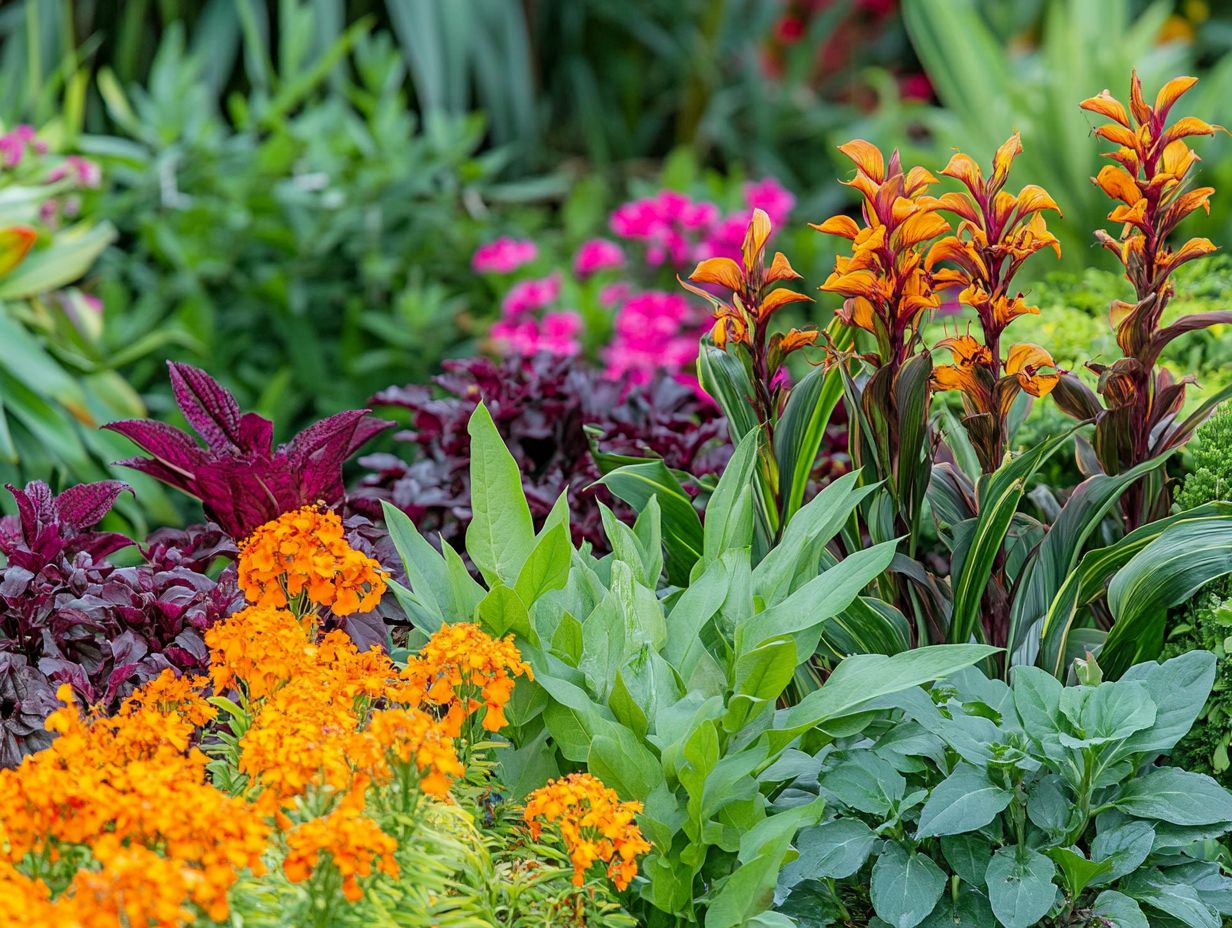
Interplanting is an advanced gardening method that allows you to grow different species of plants in close proximity. This leverages their complementary growth patterns and resource needs.
This approach maximizes your available space and cultivates a more intricate ecosystem that supports crop diversity and fosters healthier plants.
By nurturing relationships between various species, interplanting becomes a powerful ally in pest management. Specific plants can repel harmful insects while attracting beneficial ones.
This practice enhances soil health. Some plants fix nitrogen, benefiting neighboring crops, while others improve soil structure with their robust root systems.
Consider these effective interplanting combinations:
- Pairing tomatoes with basil can elevate flavor and deter pests.
- Cultivating carrots alongside onions helps mask their scent from pesky carrot flies.
These thoughtful relationships create a symbiotic environment. They ensure your organic garden thrives sustainably and productively.
Trap Cropping
Trap cropping is a strategic approach where you plant specific crops that are more enticing to pests than your main crops. This effectively diverts pests and manages invasive species.
This technique alleviates pest pressure on your valuable plants. It also fosters a thriving environment for beneficial insects by providing them with a reliable food source.
Understanding how trap cropping works is crucial for successful implementation. You ll need to carefully select trap crops that lure pests away from your primary crops.
The significance of this method in integrated pest management is immense. It reduces reliance on chemical interventions, promoting a more sustainable agricultural practice.
For example, planting mustard or radish as trap crops can effectively divert aphids away from vegetables like cabbage.
These strategic trap crops not only draw in harmful pests. They can also serve as green manure, which refers to plants grown to improve soil fertility when turned into the soil.
Repellent Planting
Repellent planting involves selecting specific herbs and flowers known for their ability to deter pests. This effectively protects the more vulnerable plants in your garden.
By incorporating varieties like basil and thyme, you can establish a natural barrier against nuisances such as the tomato hornworm and cabbage worms.
Adding marigolds and nasturtiums to your garden can enhance this strategy. These vibrant flowers repel unwanted insects while inviting pollinators into your space.
Their bright blooms enhance the beauty of your garden and foster biodiversity.
Utilizing garlic and mint can help fend off a broader range of pests. This allows for a multi-layered approach to organic gardening.
By thoughtfully blending these plants, you can create a thriving environment that minimizes your reliance on chemical pesticides. This nurtures a healthier ecosystem for both your plants and the wildlife sharing your garden.
Choosing the Right Companion Plants
Selecting the perfect companion plants demands a thoughtful approach. Consider factors such as plant compatibility, growth habits, and their influence on soil health.
This careful consideration is key to cultivating a successful and harmonious garden.
By evaluating the needs of your plants and understanding their interactions, you can elevate your organic gardening practices. This optimizes your crop yields to their fullest potential.
Factors to Consider
When selecting companion plants, consider several critical factors: growth rates, nutrient requirements, and potential pest interactions. Understanding these elements allows for effective pairings that enhance biodiversity and uphold organic gardening principles.
By recognizing the unique characteristics of each plant, you can cultivate harmonious ecosystems in your garden. Fast-growing species can provide shade for slower-growing counterparts, shielding them from harsh sunlight and helping conserve moisture in the soil.
Choosing plants with complementary nutrient requirements ensures they won’t compete for the same resources. This promotes healthier growth and ultimately leads to better harvests. Some plants can naturally repel pests or attract beneficial insects, creating a balanced environment that reduces the need for chemical interventions.
Your thoughtful selection of companion plants not only supports the health of individual plants but also contributes to the overall resilience of your garden ecosystem.
How to Implement Companion Planting
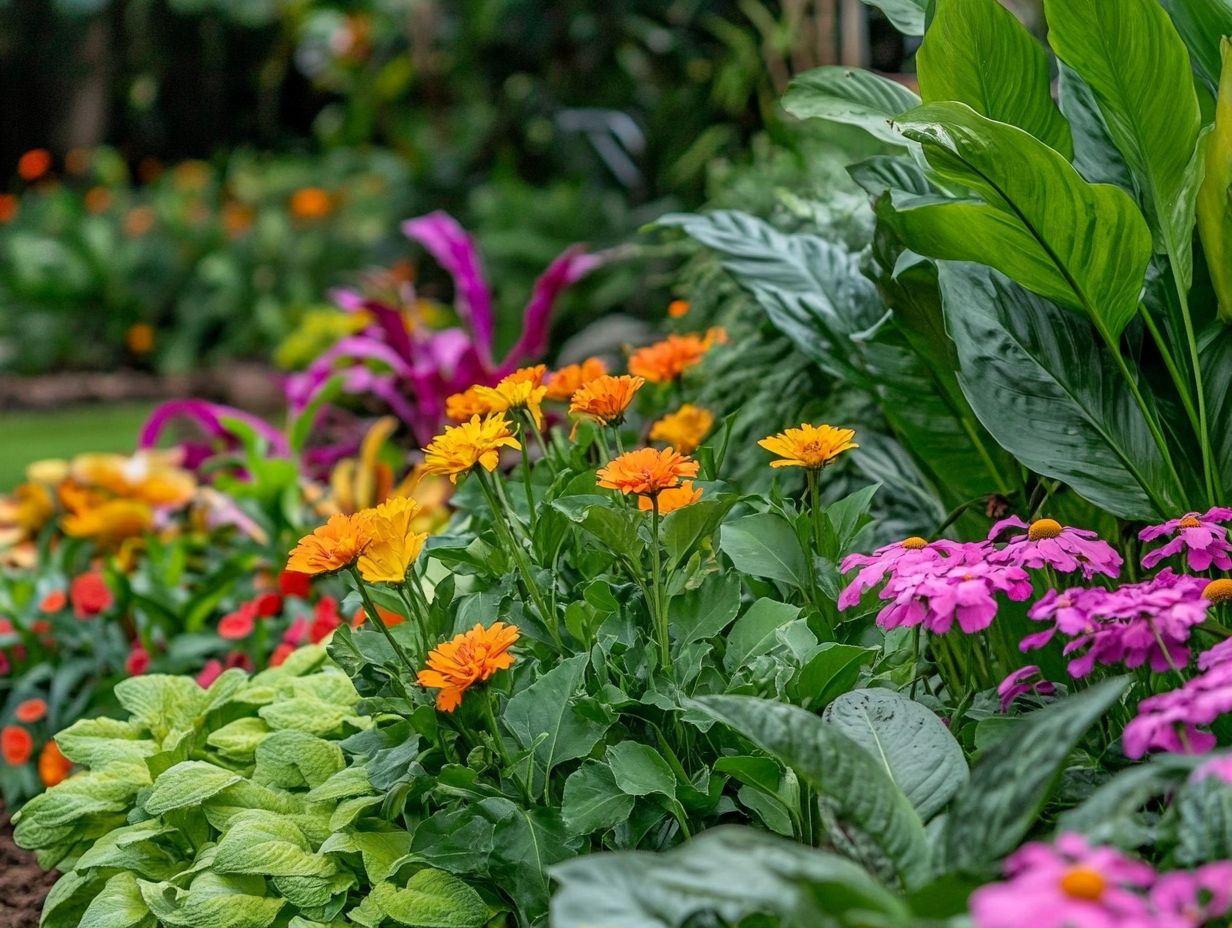
Follow this step-by-step guide to easily implement companion planting. This approach emphasizes careful planning, suitable plant pairings, and continuous management to foster optimal growth and health.
Start your organic gardening endeavors by adhering to a structured approach.
Step-by-Step Guide
This guide involves essential phases like planning, selecting compatible plants, and monitoring interactions throughout the growing season. This strategy aids in pest management and fosters healthier plant growth.
Begin by mapping out your garden layout, considering sunlight exposure and the space each plant requires. Research and choose plant pairs that naturally thrive together think tomatoes and basil or carrots and onions.
As the season progresses, regular observation becomes crucial. Watch for plant health, growth patterns, and any signs of pest activity. Be ready to make adjustments, such as relocating plants or introducing natural repellents. Embrace a mindset of continuous learning and adaptation for a flourishing organic gardening experience.
Common Mistakes to Avoid
Companion planting can elevate your gardening experience. Avoiding common mistakes can make your gardening adventure even better! Identify pitfalls like poor plant pairings and overlooking soil health to refine your pest management strategies.
These insights will lead to a thriving garden that reflects your dedication and expertise.
Tips for Success
To ensure success in companion planting, follow several key tips. Select plants that complement one another, understand their growth habits, and create an environment that attracts beneficial insects. These practices can significantly enhance your organic gardening outcomes and improve your pest management strategies.
Recognize which plants naturally support each other in terms of nutrient uptake and pest deterrence. Pairing fragrant herbs with vegetables can effectively mask their scent from pesky intruders.
Embrace a diverse garden layout to boost biodiversity and cultivate a habitat that attracts pollinators and predatory insects. Integrating flowers like marigolds or borage creates a thriving ecosystem that curbs pest populations, promoting healthier plant growth.
Frequently Asked Questions
For more information and guidance on companion planting, explore our resources and start your planting journey today!
What is companion planting and how does it help manage pests?
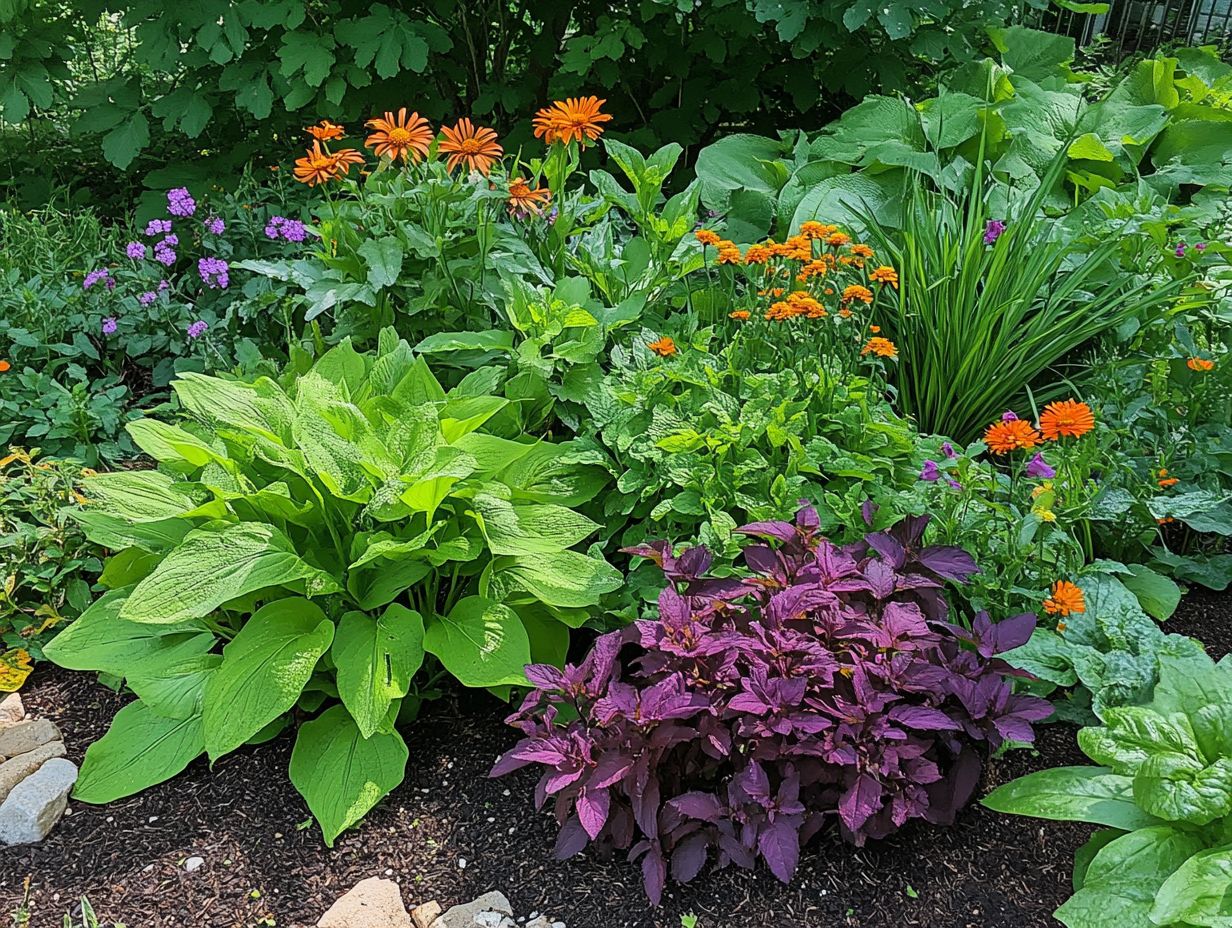
Companion planting means growing different plants together that help each other. It attracts helpful insects and keeps harmful ones away.
Which plants are best for companion planting to manage pests?
Some popular companion plants include marigolds, basil, rosemary, and lavender. These plants naturally attract good insects or repel the bad ones.
Can companion planting completely eliminate the need for pesticides?
Companion planting can cut down the use of pesticides. However, don t forget to keep an eye on pest activity and address infestations if they happen.
How do I know which plants to pair together for companion planting?
Research the pests you want to manage and find out which plants they like or dislike. Also, consider how well the plants will grow together.
Do different types of pests require different companion plants?
Yes! Different pests are attracted to various plants and might respond differently to companion plants. Research the pests you have and choose companion plants wisely.
Are there any potential downsides to using companion planting for pest management?
Companion planting can be effective, but there are downsides. Some plants might compete for resources or attract unwanted pests, so plan carefully for the best results.



